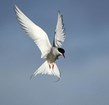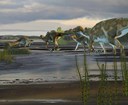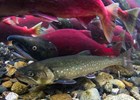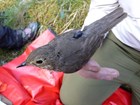Alaska is home to many amazing animal migrations. In this issue, you will read about caribou, salmon, Golden Eagles, Swainson's Thrushes, beluga whales, and more. Human migrations have also occurred here, from ancient Beringia to the Klondike Gold Rush. You can even read about now-extinct species from the Cretaceous and Pleistocene eras. Enjoy this issue of Alaska Park Science and read about migration. Alaska Park Science 17(1), 2018.
-
Article 1: Download Alaska Park Science, Volume 17, Issue 1, 2018

Migration: On the Move in Alaska. Alaska is home to many amazing animal migrations. In this issue, you will read about caribou, salmon, Golden Eagles, Swainson's Thrushes, beluga whales, and more. Human migrations have also occurred here, from ancient Beringia to the Klondike Gold Rush. You can even read about now-extinct species from the Cretaceous and Pleistocene eras. Enjoy this issue of Alaska Park Science and read about migration. Alaska Park Science, 17(1), 2018. Read more
-
Article 2: Migration: On the Move in Alaska

The far north provides both challenges and benefits to the people and animals that live here. Migration is one way people and animals can find new resources in order to survive and thrive. This is the introductory article in the Alaska Park Science issue on migration. Read more
-
Article 3: A Survey of Human Migration in Alaska's National Parks through Time

Ancient hunter-gatherers of the Arctic and Subarctic regions were nomadic people that moved camp regularly with the seasons. Ethnographic data show Native Alaskan populations typically limited their residential moves within familiar territories; however, the archaeological record demonstrates there were times in prehistory when humans spread from their homelands to new areas, sometimes lands where humans had never lived before. This is the story of Beringian migration. Read more
-
Aniakchak National Monument & Preserve
Article 4: Duck-billed Dinosaurs (Hadrosauridae), Ancient Environments, and Cretaceous Beringia in Alaska’s National Parks

This article presents new information from Aniakchak National Monument and Preserve on the Alaska Peninsula, that sheds light on the likely ancient environment that allowed the migration of one group of dinosaurs, the hadrosaurs (duck-billed dinosaurs), across Beringia during the Cretaceous. Alaska Park Science 17(1), 2018. Read more
-
Article 5: Pleistocene Megafauna in Beringia

At the peak of the last ice age, 20,000 years ago, when most of northern North America was covered by massive glaciers, much of Alaska was ice-free and home to a diverse assortment of large mammals. Learn more about how the ice age megafauna migrated across the land bridge and what species successfully survived. Alaska Park Science 17(1), 2018. Read more
-
Klondike Gold Rush National Historical Park
Article 6: The Klondike Gold Rush: A Search for the Archaeological Traces of an Historic Migration Event

People have been migrating into and through Alaska for over 14,000 years. The last major migration into Alaska began with the Russian colonialism in the mid-late 18th century and intensified with the arrival of Euro-American traders, missionaries, and prospectors in the mid-late 19th century. The Klondike Gold Rush from 1896-1899 was a particularly intense, but brief, wave of migration that would forever change the course of history for Alaska. Alaska Park Science 17(1), 2018 Read more
-
Article 7: Future Challenges for Salmon and the Freshwater Ecosystems of Southeast Alaska

Mass animal migrations are awe-inspiring sights. Every summer and fall, residents and visitors to Alaska can witness one of the great underwater migrations: Pacific salmon returning from the ocean to their home streams, rivers, and lakeshores to spawn. Hundreds of millions of salmon return to Alaska’s freshwaters annually. Alaska Park Science 17(1), 2018. Read more
-
Article 8: History, Purpose, and Status of Caribou Movements in Northwest Alaska

Migration is a distinctive behavioral trait of caribou. Caribou display the longest terrestrial migrations anywhere on the planet. In northwest Alaska, caribou travel up to 2,737 miles (4,404 km) per year. One of the main purposes of migration is to minimize exposure to predation, especially during calving when young animals are particularly vulnerable. Alaska Park Science 17(1), 2018. Read more
-
Article 9: Influence of Spring Prey Pulses on Seasonal Migrations of Pinnipeds in the North Pacific Ocean

Central to understanding the migration of organisms is an understanding of why they move. Explanations for migratory behavior may include reducing the risk of predation, enhancing access to breeding opportunities, or, in the case of seals and sea lions, enhancing access to aggregations of high-quality food or shifting patterns of food abundance. Alaska Park Science 17(1), 2018. Read more
-
Article 10: Seasonal Sea Ice and Arctic Migrations of the Beluga Whale

Sea ice break-up in the spring and freeze-up in the fall govern the accessibility of Alaska’s Arctic Ocean for several migratory marine species. Each year, beluga and bowhead whales navigate the Bering Strait and enter the southern Chukchi Sea, one of the most seasonally productive regions of the global oceans. Some belugas and most bowhead whales continue on their >1,500 mile migration north of Alaska to the Canadian Beaufort Sea. Alaska Park Science 17(1), 2018. Read more
-
Denali National Park & Preserve
Article 11: Statewide Movements of Non-territorial Golden Eagles in Alaska During the Breeding Season: Information for Developing Effective Conservation Plans

Telemetry studies provide new information on the movements of non-territorial (migrating) Golden Eagles in Alaska during the breeding season, expanding our understanding of the ecology of this species. This information should be useful for developing effective management and conservation. Alaska Park Science 17(1), 2018. Read more
-
Denali National Park & Preserve
Article 12: Connecting Taiga to Tropics: Swainson's Thrush as a Model for Nearctic-Neotropical Migration in Alaska

Twice a year, the Swainson’s Thrush connects the boreal forests of North America to the tropical forests of Central and South America through its flight across the Western Hemisphere. About 200 bird species, primarily songbirds such as thrushes and warblers, are considered Nearctic-Neotropical migrants that fly thousands of miles annually between breeding and wintering areas. Alaska Park Science 17(1), 2018. Read more
-
Article 13: Bridging the Boreal: Landscape Linkages Connecting the Federal Conservation Estate in Alaska

Migration, like other ecological functions and processes, depends on connected landscapes. Alaska’s vast forests, river valleys, and mountain ranges provide wildlife with diverse habitats and the ability to move between them as conditions require. In this article, read why landscape connectivity is important and how to plan for connectivity given climate change. Alaska Park Science 17(1), 2018. Read more
-
Article 14: Migration's Foundation: Ecological Intactness of Alaska's Ecosystems

The future of migration in Alaska depends on the capability of landscapes to support it. It is clear current landscape permeability and ecosystem integrity will change; however, the intactness of habitats in Alaska provides an enviable foundation for ensuring successful adaptation to those changes. Alaska Park Science 17(1), 2018. Read more
